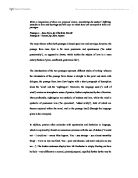In addition, passion often coincides with spontaneity and hesitation in language, which is explored by Brontë on numerous occasions with the use of dashes (‘I would not – I could not – marry Miss Ingram. You – you strange – you almost unearthly thing! – I love as my own flesh. You – poor and obscure, and small and plain as you are –’). The broken sentences display how Mr Rochester is simply blurting out how he feels – very different to a normal, planned proposal; signified further by the way he describes Jane (‘unearthly’, ‘poor and obscure’.) By contrast, in Emma, Mr. Knightley would not dream of referring to Emma in the same manner; his language is far more repressed as it is always ‘gentleman-like English’ and ‘such as Mr Knightley used even to the woman he was in love with’.
A feminist is a person whose beliefs and behaviour are based on feminism (belief in the social, political, and economic equality of the sexes). Jane Eyre is clearly a critique of assumptions about both gender and social class. It contains a strong feminist stance; it speaks to deep, timeless human urges and fears, using the principles of literature to chart the mind’s recesses. Thus, Jane Eyre is an epitome of femininity - a young independent individual steadfast in her morals and has strong Christian virtues, dominant, assertive and principled. That itself is no small feat. Bronté writes in first person so the text sounds personal and as if
Jane is telling you things from the heart showing her emotions. Using
this technique makes it more direct to the reader and sound like its
coming from Jane's point of view and not somebody else's, this is a
useful technique because it makes the reader feel they can get into
Jane's mind. Jane is a spirited woman, and her emotions give her a strength of character that is unusual for a female heroine of this period. Rather than being nervous and oversensitive, Jane expresses her feelings through anger. The first example of this occurs at one of the pivotal moments of her life, when John Reed hits her. "'Wicked and cruel boy!' I said. 'You are like a murderer- you are like a slave-driver- you are like the Roman emperors!' I had read Goldsmith's History of Rome, and had formed my opinion of Nero, Caligula, etc.
Emma's life was greatly influenced by her reading. She lived in a world of fiction rather than in the real world. She wanted the things she read about to come alive in her own life. The idea of romantic nights, old castles, and moonlight meetings supplied a satisfaction in her that she couldn't find anywhere else. She needed constant excitement and change. If she never read these romantic novels, then she would not have been a dreamer and a sentimentalist. Her normal life of everyday living would have kept her content rather than intolerable.
Emma discovered romantic novels as a young girl living in a convent. Unable to see the real world or the realities of everyday living, she was left alone with her dreams. She concentrated all of her attention on them and nothing else. These novels influenced her entire approach to life.
The differences between Emma by Jane Austen, a classical novel, and the
autobiographical slave narrative, The History of Mary Prince are many and varied, but
what stood out in my mind most prominently was the difference in character development. The novel delved very deeply into the life, character, breeding, make-up, and personality of it’s subjects, but the narrative, instead, developed Prince in breadth, not depth. While each approach gave the reader insight into the respective lead characters, one came away with a better understanding of who Emma was and why. A novel is a long work of written fiction. Most novels involve many characters
and tell a complex story by positioning the characters in a number of different situations. A novels chief interest is in the human character as it manifests in society. The individual naming of the characters in a novel gives singularity to each person. Novels tend to be richly detailed and often have an exhaustive analysis of human relationships. In a novel, the writer has the freedom to develop the plot, characters, motifs, and theme slowly – which all three of these do.








